Amna A. Abdalla1, Mahmoud F. Ahmed2, Musa B. Taha1, Ahmed M. El Naim3
1Agricultural Research Corporation, Wad Medani, Sudan
2Department of Agronomy, Faculty of Agriculture, University of Khartoum, Shambat, Sudan
3Department of Crop Sciences, Faculty of Natural Resources and Environmental Studies, University of Kordofan, Elobeid, Sudan
Correspondence to: Ahmed M. El Naim, Department of Crop Sciences, Faculty of Natural Resources and Environmental Studies, University of Kordofan, Elobeid, Sudan.
| Email: |  |
Copyright © 2015 Scientific & Academic Publishing. All Rights Reserved.
Abstract
Faba bean crop in the Sudan is the main source of protein for the middle and low income strata of the population. Environment an important role in the proper stand establishment of the growing crop, which ultimately affect the productivity and quality at the end of the growing season. A field experiment was conducted in the Sudan for three consecutive seasons (2005/06, 2006/07 and 2007/08), at five different environments to investigate the effect of these environments on yield components of Faba bean (Vicia faba L.). The environments where: (E1): Al Salama location to represent lower terrace soil (Riverian); (E2): Hudeiba Research Station Farm to represent middle terrace soil (Karu); (E3): Almatara location; to represent high terrace soil; (E4): Wad Medani location (Gazira Research Station Farm) to represent central clay plain soil; (E5): Ed Damer Food Security Scheme location to present high terrace soil. The selection was based on different soil types and different climatic growing conditions. Six Faba bean lines were selected for this study; namely: Small-medium seeded (H.72/7/1, Daba.1/1, Z B F.1/1, C.86 and Triple White); and large seeded Turki. The experiment was arranged in a Randomized Complete Block Design (RCBD) with three replications in the three seasons; cultural practices were carried out according to the recommendations of ARC. Characters studied included, yield parameters: number of pods per plant, number of seeds per pod and 100-seed weight. The results showed that the environments had significant effect on yield components. The high number of pods per plant, high number of seeds per pod and heavier pods were produced from lower terrace soil (Riverian) in E1 (Al Salama location). However, the lowest yield components of faba bean were recorded from high terrace soils in E3 (Almatara location) and E5 (Ed Damer Food Security Scheme).
Keywords:
Terrace soil, Environment, Faba bean, Cultivars, Sudan
Cite this paper: Amna A. Abdalla, Mahmoud F. Ahmed, Musa B. Taha, Ahmed M. El Naim, Effects of Different Environments on Yield Components of Faba Bean (Vicia faba L.), International Journal of Agriculture and Forestry, Vol. 5 No. 1, 2015, pp. 1-9. doi: 10.5923/j.ijaf.20150501.01.
1. Introduction
Faba bean is the most important food legume in the Sudan. It is the main staple food and the main source of protein for millions of people. Its nutritional importance is even greater as many people have limited access to animal food protein. Its consumption increased among the middle and low income strata of the population, being the traditional dish for breakfast and supper. Further demand has, however, increased over time in the whole country to magnitudes that increasing productivity would be essential to satisfy the local needs. Faba beans are traditionally grown in the fertile (Gureir) soils, those are silty loams deposited in a narrow strip along the banks of the Nile and on isolated islands. Due to the scarcity of fertile soils and the high demand for faba bean, coupled with the ever increasing prices, new land of inferior quality such as 'karu' and 'high terrace' soils are coming up into production. Faba bean requires a cool season for best development. It is grown as a winter annual in warm temperate and subtropical areas; hardier cultivars in the Mediterranean region tolerate winter temperatures of -10°C without serious injury whereas the hardiest European cultivars can tolerate up to -15°C [1] "It can be grown anywhere and does not winterkill. Tolerates nearly any soil type; grows best on rich loams. Moderate moisture supply is necessary" [2]. They are considered as the least drought resistant of legume crops; however, cultivars with high water use efficiency have been developed at ICARDA [1]. "Moisture requirement is highest about 9-12 weeks after establishment. Faba bean is more tolerant to acid soil conditions than most legumes. Growing seasons should have little or no excessive heat, optimum temperatures for production range from 18 to 27°C (65-85°F)" ([2]. Rainfall of 650-1000 mm per annum evenly distributed is ideal [3]. The maturity period ranges from 90-220 days depending upon the cultivars and climatic conditions [4].The main objective of this study is to investigate the effect of soil type and thermal environment on yield components of Faba bean.
2. Materials and Methods
A field experiment was conducted for three consecutive seasons (2005/2006, 2006/2007 and 2007/2008), at five environments to investigate the effect of these environments on yield components of faba bean (Vicia faba L.). The selected environments were mainly to represent different soil types. In addition, temperature and relative humidity during the growing seasons were also considered. The environments where: Environment 1 (E1): Al Salama location: an island 17 kilometers from Atbara city, longitude 33° 99` E, latitude 17° 84` N and altitude 348 meters above sea level to represent lower terrace soil (Riverian). Environment 2 (E2): Hudeiba Research Station Farm, longitude 33° 92` E, latitude 17° 56` N and altitude 350 meters above sea level to represent middle terrace soil (Karu). Environment 3 (E3): Almatara location 1.5 kilometers from Hudieba Research Station, longitude 33° 95` E, latitude 17° 56` N and altitude 351 meters above sea level to represent high terrace soil. Environment 4 (E4): Wad Medani location Gezira Research Station Farm, longitude 33° 29` E, latitude 14° 24` N and altitude 410 meters above sea level to represent the Central clay plain soil. Environment 5 (E5): Ed Damer Food Security Scheme location 2.5 kilometers from Almatara location, longitude 33° 97` E, latitude 17° 54` N and altitude 355 meters above sea level to present high terrace soil (this environment was added in the second and third seasons to study another location of the high terrace soil).The soil physical and chemical properties for all sites were described and shown in Table 1 and 2 respectively.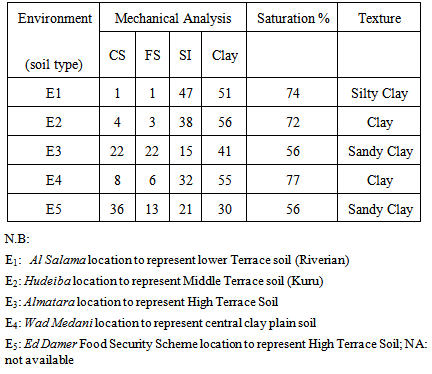 | Table 1. Physical properties of the study soils |
 | Table 2. Chemical properties of the study soils |
The monthly mean maximum and minimum temperatures and relative humidity during the experimental period were recorded (from Hudeiba Meteorological Station and Gezira Meteorological Station) for the three seasons and are shown in Table 3.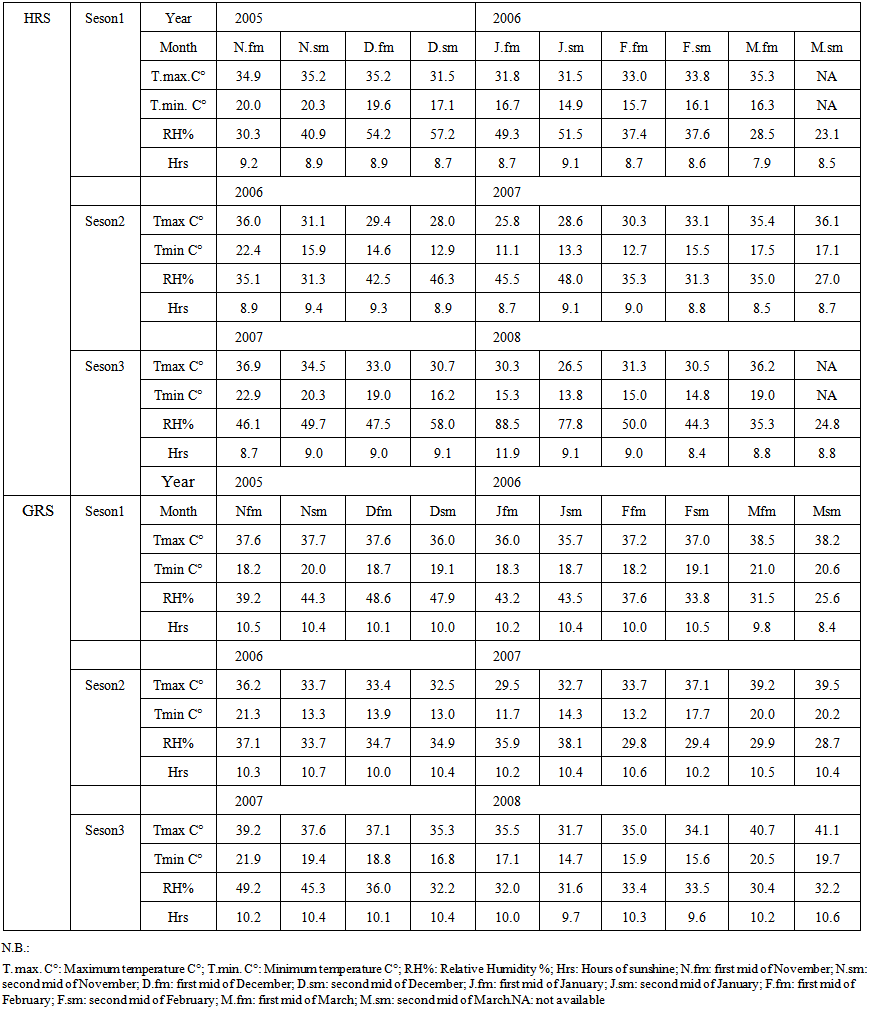 | Table 3. Temperature, relative humidity and hours of sunshine of Hudeiba and Wad Medani during the months of the study seasons |
Six Faba bean lines were used in this study; namely: small-medium seeded (H.72/7/1, Daba.1/1, Z B F.1/1, C.86 and Triple White); and large seeded Turki. The experiment was arranged in a Randomized Complete Block Design (RCBD) with three replications in the three seasons. The land was pre-irrigated and then prepared by disc ploughing, harrowing and ridging at 60 cm apart. Spacing between plants was 10 cm in all seasons. The size of the individual plot was 6 x 3.6 meters consisting of six ridges. The two outer ridges on each plot were left as guard while the inner ridges were used for yield determination. Sowing was done manually on the shoulder of the ridges on the first half of November in River Nile locations, whereas at Wad Medani location it was sowing on the first week of December. The lines were planted at a rate of 3 – 4 seeds per hole and then three weeks later were thinned to 2 plants per hole to gain the recommended plant population (33 plants /m2). Weeds were controlled three times by hand. Crops were irrigated at 8 – 10 days intervals. Characters studied included: yield parameters number of pods per plant, number of seeds per pod and 100-seed weight. The data were statistically analyzed using IRRSTAT software computer packages.
3. Results and Discussion
3.1. Number of Pods Per Plant
In the three seasons, the mean number of pods per plant was affected by all treatments. Statistical analysis revealed that environment, line and their interaction had a highly significant effect on mean number of pods per plant in the three seasons (Tables 4a-c). In this study, the overall mean number of pods per plant was greater in the second season compared to the first and third seasons. Averaging over lines, plants grown at E1 (Al Salama location) and E2 (Hudeiba location) had significantly higher mean number of pods per plant compared to plants grown at E3 (Almatara), E4 (Wad Medani) and E5 (Ed Damer) in the three seasons (Tables 4a-c).Averaging over environments, Triple White had significantly greater mean number of pods per plant in the three seasons, while Turki produced the lowest number of pods per plant in the three seasons (Tables 4a-c). In the present study, number of pods per plant was positively correlated with seed yield (Table 7). Similar findings were reported by Muehlbauer, et al. [5] who stated that, yields are closely correlated with the number of pods per plant. However, Berhe, et al. [6] found that, number of pods per stem had significant positive associations with seed yield only at low and mid-altitudes while it was not significant at high altitud. | Table 4(a). Effect of environment, line and their interaction on number of pods per plant of faba bean grown during 2005/2006 season |
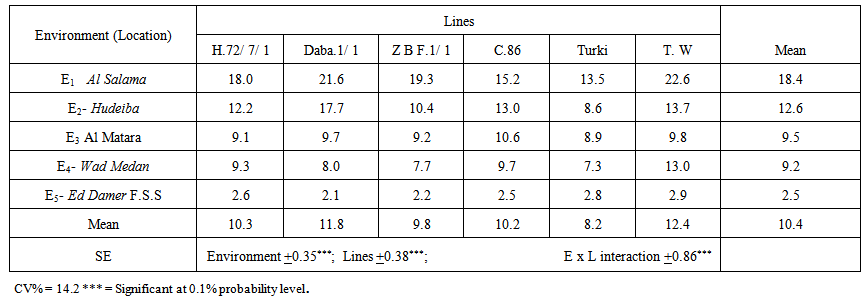 | Table 4(b). Effect of environment, line and their interaction on number of pods per plant of faba bean grown during 2006/2007 season |
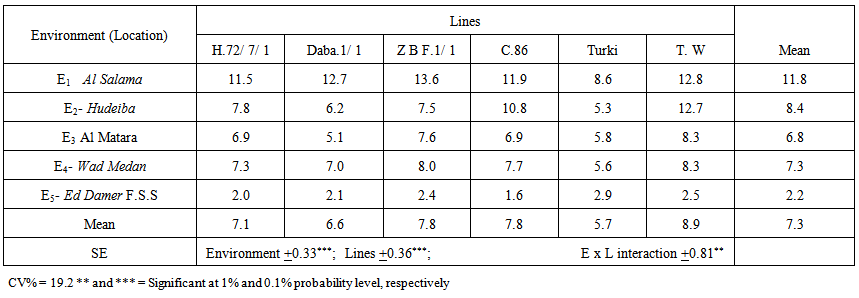 | Table 4(c). Effect of environment, line and their interaction on number of pods per plant of faba bean grown during 2007/2008 season |
3.2. Number of Seeds Per Pod
Number of seeds per pod of faba bean lines at different environments in the three seasons is presented in Tables 2a-c. Analysis of variance showed that environment and line had a highly significant effect on mean number of seeds per pod in the three seasons. Differences due to environments and lines interaction on mean number of seeds per pod were significant in the second and third seasons only. In the first and second seasons there was slightly a greater number of seeds per pod than in the third season (Tables 5a-c).Irrespective of lines, plants grown at E1 (Al Salama) and E2 (Hudeiba) produced significantly more seeds per pod than those grown at the other environments (Tables 5a-c). A contrasting result was reported by Mohammed Osman, et al. [7] who mentioned that number of seeds per pod showed no significant differences; that the trait was genetically controlled and not affected by environment.Averaging over environments, both the most fertile line Triple White (Table 4a-c); and the heaviest seeds cultivar Turki (Tables 6a-c) had significantly lower seeds per pod compared to the other lines in the three seasons (Tables 5a-c). This result is in agreement with the general knowledge that there was strong competition among number of pods per plant, number of seeds per pod and seed weight; these three characters have negative relationship among themselves. | Table 5(a). Effect of environment, line and their interaction on number of seeds per pod of faba bean grown during 2005/2006 season |
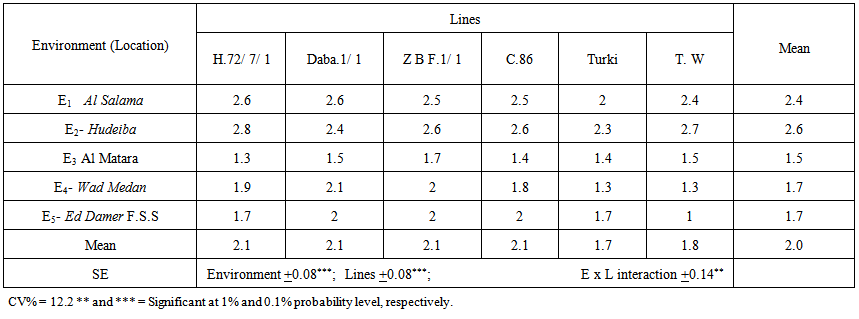 | Table 5(b). Effect of environment, line and their interaction on number of seeds per pod of faba bean grown during 2006/2007 season |
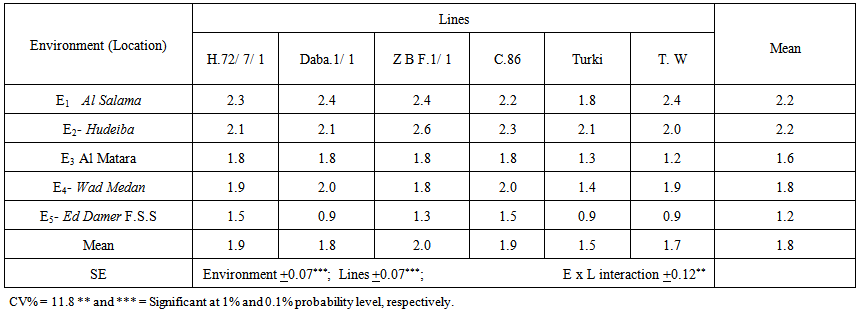 | Table 5(c). Effect of environment, line and their interaction on number of seeds per pod of faba bean grown during 2007/2008 season |
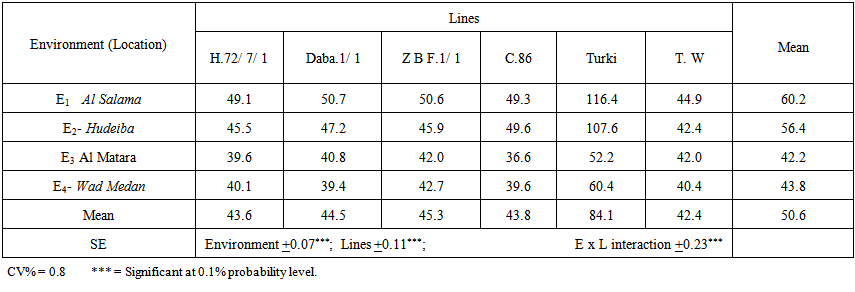 | Table 6(a). Effect of environment, line and their interaction on 100 seed weight (g) of faba bean grown during 2005/2006 season |
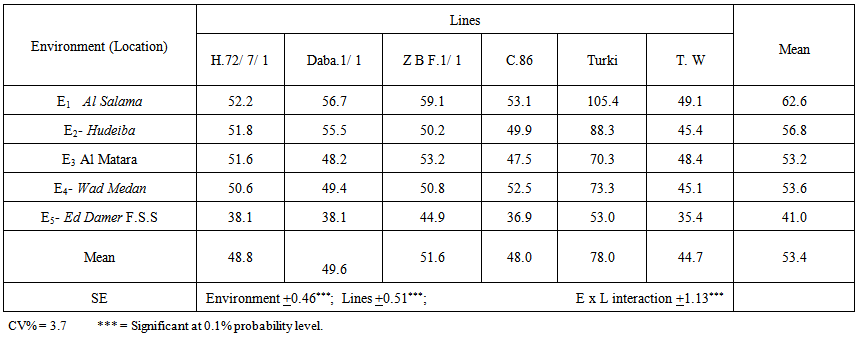 | Table 6(b). Effect of environment, line and their interaction on 100 seed weight (g) of faba bean grown during 2006/2007 season |
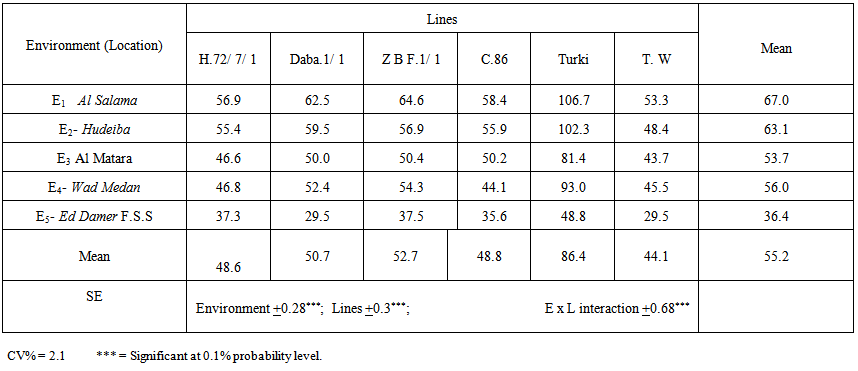 | Table 6(c). Effect of environment, line and their interaction on 100 seed weight (g) of faba bean grown during 2007/2008 season |
The results showed that there was a positive correlation between seeds per pod and seed yield (Table 7). Similar results were reported by Berhe, et al. [6] who stated that correlation analysis showed that number of seeds per pod and seeds per plant had significant positive associations with seed yield across the three environments. However, Loss and Siddique [8] reported that seed number per pod was relatively constant across times of sowing. On the other hand, Idris [9] reported that seed size did not show a significant effect on the number of seeds per pod. 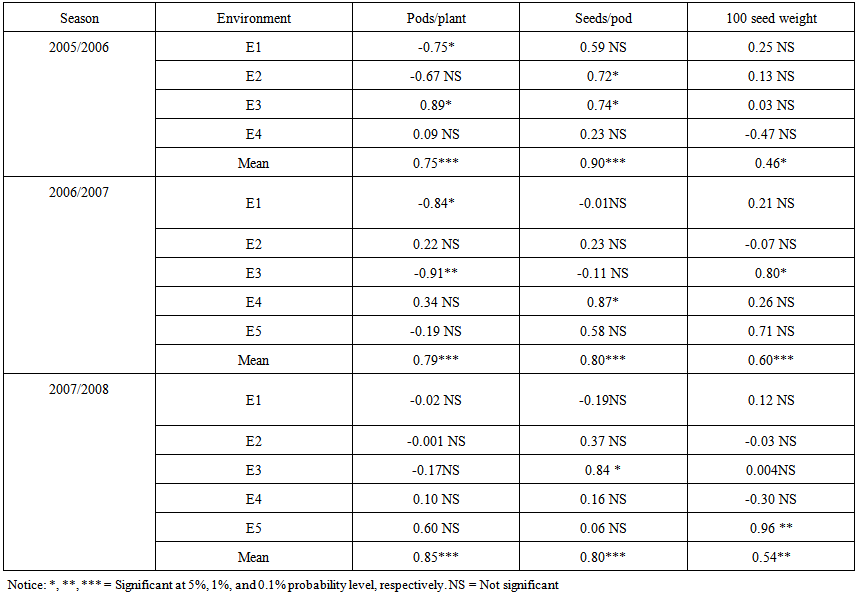 | Table 7. Correlation (r) between grain yield of Faba bean lines and the yield components measured in each experimental site of the trial |
3.3. 100 Seed Weight (g)
Seed weight of faba bean lines at different environments in the three seasons is presented on Tables 6a-c. Analysis of variance showed that environment, line and their interaction had a highly significant effect on mean 100 seed weight in the three seasons. The overall mean seed weight was greater in the third and second seasons (particularly the third season) compared to the first season (Tables 6a-c).This result may be attributed to the relatively cool temperature during the grain filing stage (January) in those seasons (Table 3). Averaged over lines, 100 seed weight was heavier at E1 (Al Salama) and E2 (Hudeiba) (60.2 and 56.4 g); (62.6 and 56.8 g); (67.0 and 63.1 g) in the three seasons respectively. However, the lowest 100 seed weight (36.4 g) was observed at E5 (Ed Damer) in the third season followed by (41.0 g) at E5 in the second season (Tables 6a-c). The results showed variations in seed weight among environments. Considerable variations within a cultivar when grown in different environments have been reported, (Picard and Berthelem, 1981). Contrasting results were reported by Toker [10] who pointed out that seed weight was the least affected trait across changing environmental conditions. Averaged over environments, Turki line significantly produced heavier seeds (84.1, 78.0 and 86.4 g) in the three seasons respectively (Tables 3a-c). Contrastingly, Triple White line had the lowest weight (42.4, 44.7 and 44.1 g) in the three seasons respectively (Tables 6a-c). Variations among lines in seed weight were found by Bianco et al. [11] who reported that seed weight varies considerably between cultivars, and ranges from 0.1 g/seed to 2.4 g/seed. Moreover, Deshpande et al. [11]); showed that, small types of beans have low hundred seed mass (100SM) with mean values of 15.03 g/100 beans, while larger beans have larger mean values of 48.77 g/100 beans. The results also showed positive correlation between 100 seed weight and seed yield (Tables 7). Contrasting results were shown by Salih and Salih [12] where seed size had little effect on seed yield. However, Salih [13] found that grading of Faba bean seeds for the grower would not be economic. Moreover, Idris [9] showed that grading the Faba bean seeds to different seed size classes had no significant effect on seed yield. However, Bond et al. [14] obtained higher seed yield from large than from small or ungraded seeds. The results showed that number of pods per plant, number of seeds per pod and 100-seed weight were the major direct contributors to seed yield consistently across the five environments. However, these characters have negative relationship among themselves. Generally, these results suggest that number of pods per plant and 100-seed weight were the most important contributors to seed yield. This result is in agreement with the findings of many researchers. In this regard Berhe et al. [6] reported that number of seeds per pod, seeds per plant, pods per plant, podding nodes per plant and pods per podding node had consistently significant and positive relationships with seed yield. However, Loss and Siddique [8] pointed out that seed yield was most strongly correlated with number of pods m-2, while Agung, et al. [15] found that there were significant differences between accessions and sites in individual yield components; and yield was not significantly correlated with any particular component. Moreover, Picard and Berthelem, [16] stated that environmental effects on yield are known to act significantly through seed size as well as seed number per plant. On the other hand, most researchers found that yield was closely related to number of pods per plant [17, 18].
4. Conclusions
Based on the results obtained the number of pods per plant, number of seeds per pod and 100-seed weight were the major direct contributors to seed yield consistently across the five environments. However, these characters have negative relationship among themselves. Generally, these results suggest that number of pods per plant and 100-seed weight were the most important contributors to seed yield.
References
| [1] | Robertson, L.D., Singh, K.B., Erskine, W. and Ali M. Abd El Moneim. 1996. Useful genetic diversity in germplasm collections of food and forage legumes from West Asia and North Africa. Germplasm Resources and Crop Evolution 43, 447-460. Kluwer Academic Publishers, Dordrecht, The Netherlands. |
| [2] | Duke, J.A. 1981. Handbook of legumes of world economic importance. Plenum Press, New York. Pp. 199-265. |
| [3] | Kay, D. 1971. Crop and Product Digest No. 3-Food legumes. Pp.26-47. London: Tropical Products Institute. UK. |
| [4] | Bond, D.A., Lawes, D.A., Hawtin, G.C., Saxena, M.C. and Stephens, J.S. 1985. Faba Bean (Vicia faba L.). Pp. 199-265. In: R.J. Summer field and E.H. Roberts (eds.), Grain Legume Crops. William Collins Sons Co.Ltd.8 Grafic street, London WIX 3LA,UK. |
| [5] | Muehlbauer. F. J. and Abebe Tullu. 1997. Vicia faba L. Purdue University, Center for New Crop and Plant Products, New Crop Fact Sheet. |
| [6] | Berhe. A., Geletu B. and Dejene M. 1998. Associations of some characters with seed yield in local varieties of faba bean. Afri. J. Crop Sci. 6 (2), 197-204. |
| [7] | Mohammed Osman, A. A., Yagoub, S. O. and Tut, O. A. 2010. Performance of faba beans (Vicia faba L) cultivars grown in new agro-ecological region of Sudan (Southern Sudan). Aust. J. Basic & Appl. Sci., 4(11), 5516-5521. |
| [8] | Loss S.P. and Siddique K.H.M. 1997. Adaptation of faba bean (Vicia faba L.) to dry land Mediterranean-type environments I. Seed yield and yield components. Field Crops Rec.52(1), 17-28. |
| [9] | Idris, A. Y. 2008. Effect of seed size and plant spacing on yield and yield components of faba bean (Vicia faba L.). J.Sci. Bio. Agric 4(2), 146-148. |
| [10] | Toker, C., 2004. Estimates of broad-sense heritability for seed yield and yield criteria in faba bean (Vicia faba L.). Hereditas. 140 (3), 222-225. |
| [11] | Deshpande, S.S., Sathe, S.K and Salunkhe, D.K., 1984. Interrelationship between certain physical and chemical properties of dry bean (Phaseolus vulgaris). Quality as Plantarum - Plant Foods for Human Nutri 34, 53-65. |
| [12] | Salih, F.A and Salih, H.S. 1980. Influence of seed size on yield and yield components of broad bean (Vicia faba). Seed Sci. Technol. 8, 175-181. |
| [13] | Salih, F. A. 1977. Seed size/ sowing date experiment. Annual Report 1975/1976, Hudeiba Research Station, Ed-Damer, Sudan. |
| [14] | Bond, D. A., Lockwood, G., Toynbee-Clarke, G., Pope, M. and Hall, J. A. 1983. Annual report of plant breeding institute, Cambridg.e |
| [15] | Agung, S. and McDonald, G. K. 1998. Effects of seed size and maturity on the growth and yield of faba bean (Vicia faba L.) Aust. J. Agric. Rec. 49(1), 79 – 88. |
| [16] | Picard, J. and Berthelem, P. 1980. A brief comment on yield stability and thousand-grain weigh in Vicia faba. FABIS 2, 20. |
| [17] | Ishag, H. M. 1973. Physiology of seed yield in field beans (Vicia faba L.). 1. Yield and yield components. J. agric. Sci., Cam. 80, 181-189. |
| [18] | Kambal, A. E. 1969. Component of yield in field beans, Vicia faba L. J. Agric. Sci., Camb. 72, 359-363. |














 Abstract
Abstract Reference
Reference Full-Text PDF
Full-Text PDF Full-text HTML
Full-text HTML